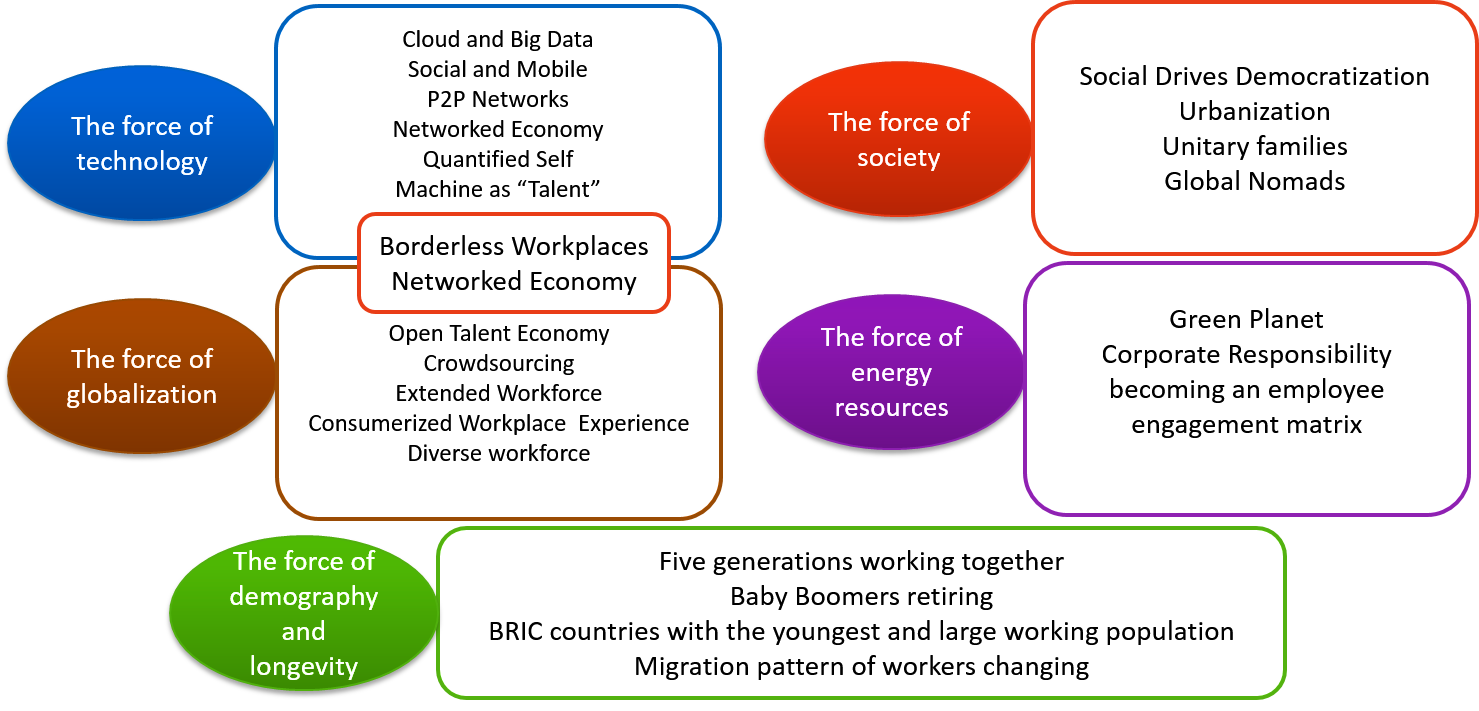Reimagining HR in a VUCA world

A Dale Carnegie Survey says that 45% of the workforce is not engaged and 26% are actively disengaged. On the other hand, 43% of highly engaged employees receive feedback at least once a week, and 71% of disengaged and discontented individuals are sharing on social media like LinkedIn and Glassdoor! If we study the numbers, we can easily see the deep, underlying messages therein.
These statistics around employee engagement is shocking and disturbing!
It is evident that employees are craving for simplification, connection, flexibility and – above all – an environment of connectedness and respect. And the impact of digitization is going far beyond a few collaboration tools and platforms. Some of these shifts are depicted in the diagram below, and their possible impact on how HR operates can be easily fathomed:

Today’s organizations are no longer defined by fixed workplaces, nine-to-five working hours or by a set of homogenous employees. Organizations are becoming boundary-less and often, location agnostic. Operational and business models are being turned on their heads with the advent of enterprises like Uber, Airbnb, Etsy and Amazon. These complexities will continue to exponentially increase as we enter a hyper-digital era with Artificial Intelligence (AI), Robotics, 3D printing, Wearables, and much more looming over the horizon. Going ahead, organizations of the future will function as platforms connecting diverse, distributed, and multi-talented individuals who will come together to create value.
It is understood that the workforce today has expanded to include contractual and contingent workers, partners, vendors and suppliers, as well as customers and competitors – the extended enterprise. This “extended enterprise” is as critical to the success of any organization as the permanent employees. However, seamlessly integrating this ecosystem of stakeholders such that they can come together in a purposeful manner to create value for the organization and fulfill their individual potentials is posing to be a challenge. In the Industrial Era, work got done in silos with process adherence and efficiency playing a huge role. This style of working will no longer suffice as we enter an era characterized by flux and ambiguity – the VUCA (Volatile, Uncertain, Complex, and Ambiguous) world.
Currently, many organizations are caught up in trying to deploy different systems of engagement like social intranets, blogs, enterprise collaboration platforms, and so on. However, these are very often disconnected from the core HR systems where organizational information and data reside. This leads to incongruence and an inability to connect the loops in the value chain. This is also where most of the digital and collaboration initiatives flounder. This is where HR can play a crucial role in bridging the two systems – not only through technology but also by re-imagining the processes, the organizational design, and other initiatives like community management, empowering employees with digital skills for them to navigate this new world with ease, and enabling and creating a culture of collaboration and sharing.
HR Reimagination can happen at multiple levels to empower employees and the organization and form the bedrock of a new organizational culture. Some of these initiatives are briefly described below:
- Extended Enterprise - Employees are no longer a homogenous set of people. Contractors, consultants, partners, vendors, customers and competitors are coming together to get the work done. Therefore, organizations that support communities consisting of this extended enterprise stand to benefit in multiple ways like improved agility, diversity of thought and greater innovation capabilities and increased level of trust among different stakeholders.
- Enterprise Social Networks (ESNs) - Organizations are becoming increasingly distributed, diverse, and digital. Employees today expect to be able to work from anywhere, anytime, and from any device. ESNs, once thought of as a “good-to-have” have transformed into “must-haves” to keep this distributed workforce connected, to enable seamless sharing of explicit and tacit knowledge, and to facilitate conversations across geographies, business units, and domains -- a critical component of the future of work. HR must don the mantle of collaboration enablers and community managers to build connected enterprises.
- Communities of Practices - Organizations today work across domains and areas of expertise. It is no longer possible for an individual or a small team of people to find solutions to complex problems, exceptions and challenges that businesses are facing today. Practitioners come together in these communities to share the latest and the best, to find innovative solutions and contribute to the growth of the domain. Individuals join communities voluntarily when they see value and can evolve both professionally and personally.
By putting communities and collaboration front and center, HR can highlight the importance of leveraging the advantages of network and emergent technology (social, mobile, analytics, etc.). This new way of working will include enterprise platforms and other collaboration enablers that, if appropriately used, reduce the cost of communication to almost zero. They can also facilitate self-driven learning, a culture of transparency and ongoing feedback, contextual and dialogue-driven problem solving. Most importantly, these tools can cut across organizational silos and tap into the organizational hive mind to build a learning agile and future-ready workplace.
This shift requires a careful and intentionally-designed workplace where collaboration and social learning is not a bolt-on aspect but a part of core business strategy. A culture of participation must be supported where “participation” does not imply bureaucratic compliance and cooperation, but thoughtful conversation and open sharing.







